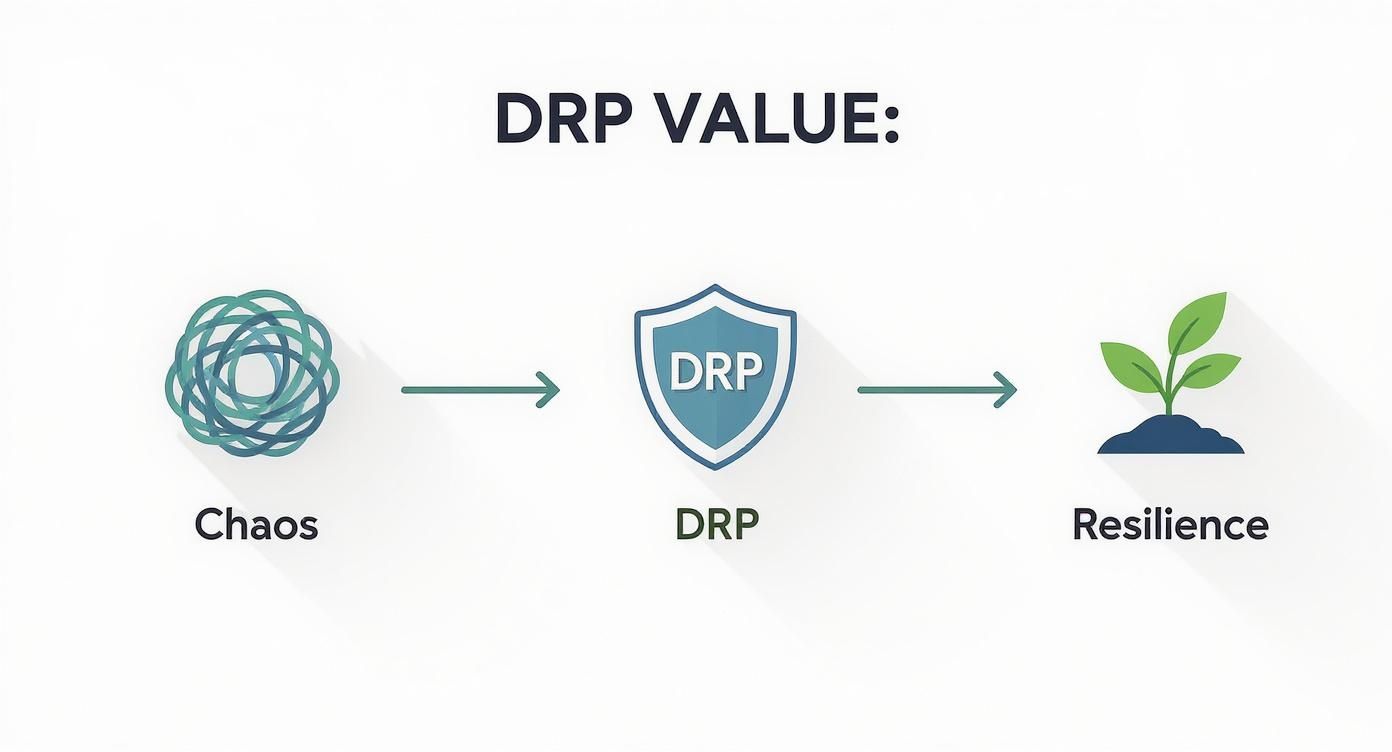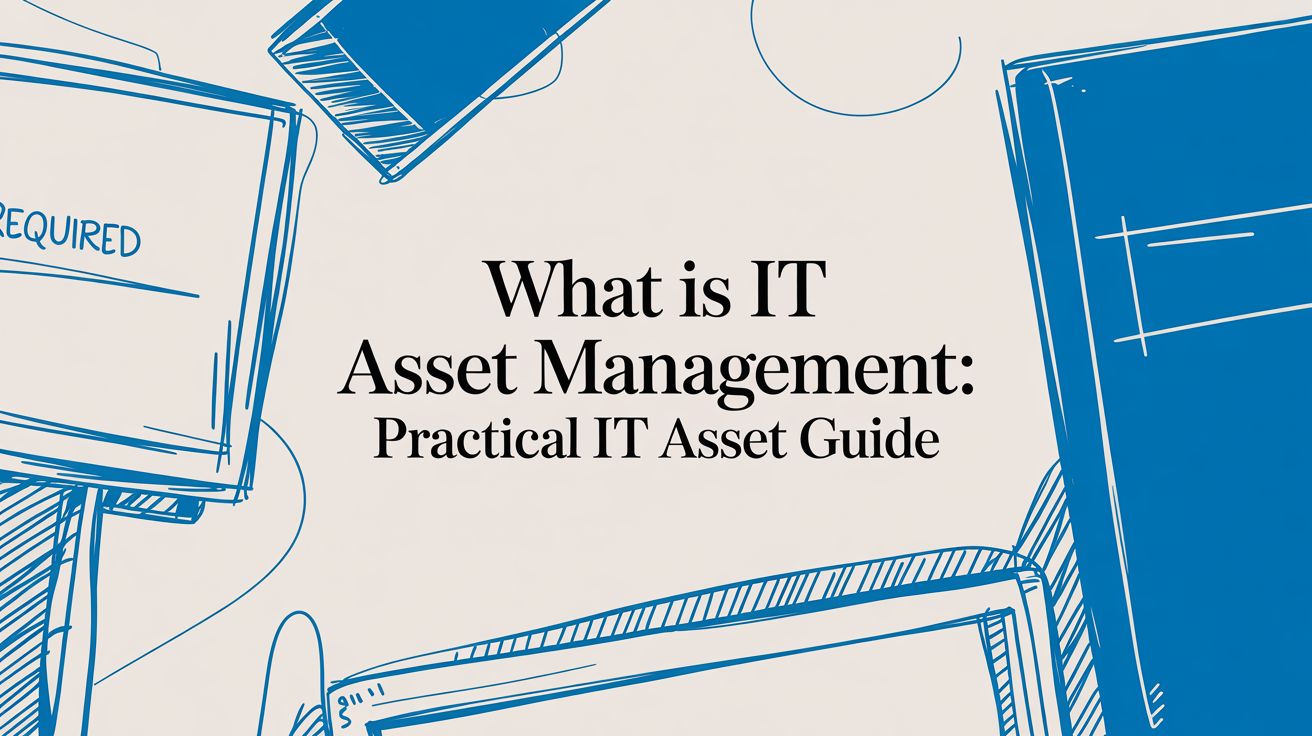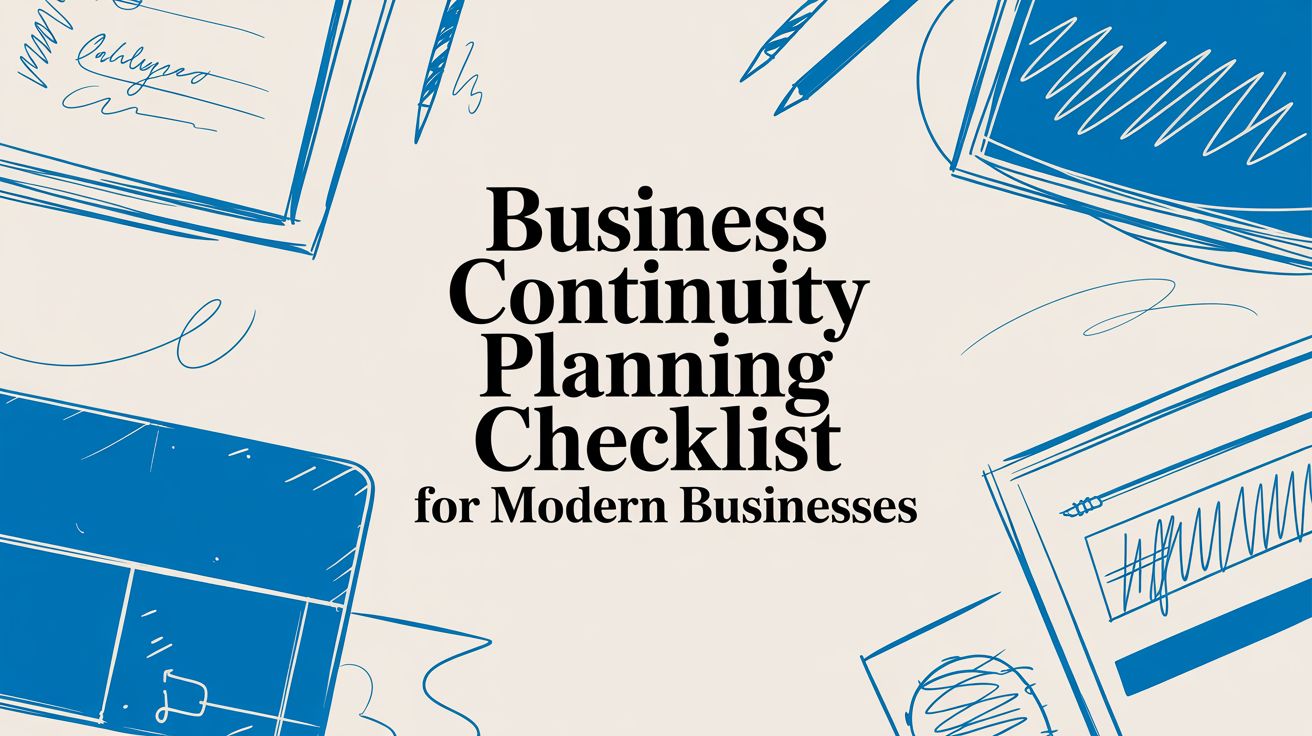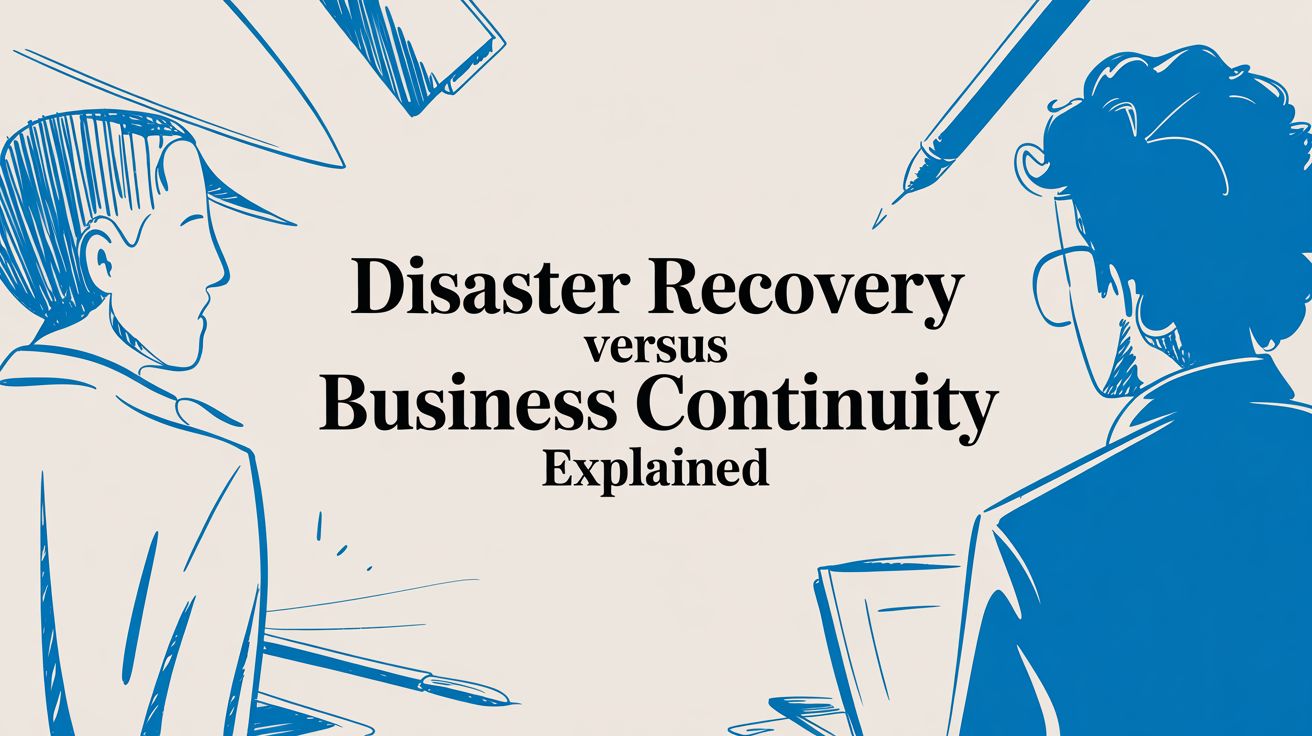What is Disaster Recovery Planning: An SMB Guide to Business Resilience
Disaster recovery planning isn't just for large corporations. For a small or mid-sized business, it's a practical game plan detailing how you'll restore your IT systems and get back to work after an unexpected outage, cyberattack, or hardware failure.
This goes far beyond just backing up your files. A disaster recovery plan (DRP) is a complete playbook that outlines the specific roles, technologies, and procedures you'll use to recover operations quickly and minimize chaos and financial loss.
What Is a Disaster Recovery Plan, Really?

It’s a common mistake for business owners to think, "We back up our data, so we're covered." This is a dangerous assumption because having backups is only one piece of the puzzle.
Think of it like this: a data backup is the spare tire in your car's trunk. It's absolutely essential, but by itself, it’s just a component.
Your disaster recovery plan is the entire roadside kit—the jack, the lug wrench, and the step-by-step knowledge of how to safely lift the car, swap the tire, and get back on your journey. When you're stranded, that spare tire is useless without the plan and tools to install it.
The Playbook for Business Survival
A solid Disaster Recovery Plan (DRP) can turn a potential catastrophe into a manageable incident. For small businesses in Dallas or Memphis, this can be the single factor that determines whether you face a few hours of downtime or have to shut your doors permanently.
A professionally managed DRP forces you to answer tough questions before a crisis hits:
- Who is in charge? The plan establishes a clear chain of command so there's no confusion during a high-stress event.
- What's most important? It helps you prioritize the recovery of your most critical applications and data first to get revenue-generating operations back online.
- How do we communicate? It creates protocols for keeping your employees, clients, and stakeholders informed.
- What are the exact steps? It details the technical process for failing over to a backup system and recovering your operations, often leveraging cloud solutions for speed and reliability.
A well-crafted DRP doesn't just protect your data. It protects your revenue, your customers' trust, and the reputation you've worked so hard to build. It’s a foundational piece of modern business continuity.
To see how a DRP fits into a larger strategy, you can explore a business continuity plan template and see how these crucial elements work together.
Why a Disaster Recovery Plan Isn't Just an Option—It's Essential
In today's digital world, operating without a disaster recovery plan is like driving without insurance. You might get away with it for a while, but you're one bad day away from a total catastrophe. For small and mid-sized businesses, an unexpected IT disaster isn't just an inconvenience; it can be the event that closes your doors for good.
Real-World Example: Imagine two competing Dallas-based logistics firms are hit by the same ransomware attack. The first company has no plan. Chaos erupts. Operations halt, employees can't access shipping manifests, and customers are left in the dark. Every minute they're offline, money walks out the door and their reputation for reliability is destroyed.
The second company, however, has a managed DRP with their IT partner. The moment the attack is detected, the plan kicks in. Their proactive security tools isolate the threat, and within hours, their systems are restored from clean, secure cloud backups. For their clients, it was barely a blip on the radar. That's the difference a proactive plan makes.
The Sobering Cost of Being Unprepared
This isn't just a story; it's a reality backed by some serious numbers. The financial toll of disasters has skyrocketed. What was once a $70 to $80 billion problem per year has exploded to over $200 billion annually in recent years. And when you add up all the related damages, the global economic loss is now a staggering $2.3 trillion each year. You can get a deeper look at these figures from the United Nations Office for Disaster Risk Reduction.
For a small business, a DRP is not just another IT expense. It's a fundamental investment in your company's ability to survive and thrive, no matter what comes its way.
A solid plan provides a clear, step-by-step guide to navigate the worst-case scenario, from a simple hardware failure to a full-blown cyberattack. It ensures your team knows exactly what to do when things go sideways. This level of readiness is what separates a controlled, manageable recovery from a business-ending crisis. A core component of this is having the right technology, which you can learn about in our guide to small business data backup solutions.
Understanding Your Recovery Objectives
A disaster recovery plan isn't just theory; it becomes a practical, actionable strategy once you define your specific goals. At the core of any solid DRP are two crucial metrics every business owner needs to understand: the Recovery Time Objective (RTO) and the Recovery Point Objective (RPO). Defining these is the key to creating a plan that actually works when you need it most.
Think of it like this: RTO is all about time. It answers the question, “How long can this system be down before it starts causing real damage to the business?” Your e-commerce website might have an RTO of just a few minutes, but your internal HR portal could likely be down for a day without causing a total meltdown.
RPO, on the other hand, is all about data. It asks, “How much data can we afford to lose?” If your server crashes at 3 PM and your last backup was from the night before, you’ve lost an entire day's worth of transactions, emails, and files. Your RPO determines if that's a minor inconvenience or an absolute catastrophe.
Defining Your RTO and RPO
Determining these numbers isn't guesswork. It comes from a business impact analysis (BIA), a process where an IT partner helps you identify which systems are most critical and what the financial and operational cost of their downtime would be.
- Recovery Time Objective (RTO): This is your restoration deadline. A very low RTO—minutes or hours—usually requires sophisticated solutions like real-time cloud replication or failover systems. A higher RTO of 24 hours might be acceptable for less critical applications and can be achieved with more traditional backup methods.
- Recovery Point Objective (RPO): This dictates your backup frequency. If you can't afford to lose more than 15 minutes of data (e.g., for a busy online store), you need backups running almost constantly. If an RPO of 24 hours is acceptable, then a nightly backup to a secure location will suffice.
This infographic breaks down how a clear plan can turn a chaotic situation into a controlled recovery.

As you can see, the path from chaos to resilience is paved with a well-structured DRP built on clear, realistic objectives.
To make this even clearer, let's compare RTO and RPO side-by-side to see how they impact your business decisions.
RTO vs RPO: What's Right for Your Business
Ultimately, choosing the right RTO and RPO is a balancing act between your operational needs and your budget.
The goal is to align your technology investment with your business needs. Not every system needs a five-minute RTO, but your most critical ones do. Making these distinctions is how you build a DRP that is both effective and affordable.
Getting a handle on these metrics is the first real step toward building a plan you can count on. For a practical guide to putting all these pieces together, check out our helpful disaster recovery plan template, designed to get you started on the right foot.
Navigating Real-World Disaster Scenarios
Knowing the definition of a disaster recovery plan is one thing; seeing it save a business from a real-world crisis is another. Let's walk through common situations that businesses in Dallas and Memphis face and see how a proactive plan makes all the difference.
The Ransomware Attack
Scenario: A Memphis accounting firm employee clicks a phishing link, and ransomware spreads across their network, encrypting every critical client file just before tax season. A note demands a huge payment to get the data back. Without a plan, this is a business-ending event that leads to chaos, lost revenue, and a destroyed reputation.
But with a solid managed DRP, the outcome is completely different.
Instead of panicking, their Managed IT partner gets an alert and immediately puts the plan into action. They isolate the infected machines to stop the spread and then initiate the recovery process. Rather than negotiating with criminals, they simply restore the entire system from a clean, secure cloud backup that was taken just hours before the breach. In hours, not weeks, the firm is back in business and ready to serve its clients.
Critical Hardware Failure
It's the middle of a busy Tuesday and your main on-site server dies, taking your CRM, accounting software, and customer files down with it. Every minute that ticks by is another minute of lost sales and frustrated customers.
With a good DRP leveraging cloud solutions, this hardware failure simply triggers an automatic failover. Your workload is instantly shifted to a backup system in a secure data center, with almost zero interruption. While your IT team works on replacing the broken server, your business continues to run smoothly.
This proactive planning is essential. Downtime isn't rare; it’s a constant threat. Recent studies show that 100% of organizations lost revenue due to IT outages in the past year, and 55% of them dealt with interruptions every single week.
When it comes to ransomware, a recovery plan isn't just a good idea—it's your only real defense. Learn more about how to protect against ransomware in our in-depth guide.
Building Your DRP with a Managed IT Partner
Knowing you need a disaster recovery plan is one thing; building one that holds up during a real crisis is another challenge entirely. Many businesses try the DIY route, but this often leads to untested backups, overlooked critical systems, and a false sense of security that shatters when it matters most.
Working with a Managed Services Provider (MSP) like PWR Technologies takes the guesswork out of disaster recovery. An expert partner brings the specialized knowledge needed to perform a proper risk assessment, design a plan that meets your specific RTO and RPO targets, and handle the entire process from implementation to testing and maintenance.

Why an MSP is Your Best Ally for Business Continuity
The true benefit of partnering with an MSP goes far beyond the initial setup. They provide the crucial, ongoing management that ensures your plan is always ready for action.
- Regular Testing and Validation: A proactive MSP doesn't "set it and forget it." They schedule and run regular tests to prove your backups are recoverable and your failover systems work as intended.
- Proactive Monitoring: With 24/7 monitoring and modern EDR solutions, they often spot and fix potential problems—like a failing hard drive or suspicious network activity—long before they can escalate into a full-blown disaster.
- Continuous Updates: As your business evolves and technology changes, your MSP will update the DRP to reflect new systems, software, and threats, ensuring the plan never becomes outdated.
This kind of partnership isn't an expense; it’s an investment in resilience. It gives your small business enterprise-level protection and lets you focus on growth with real peace of mind.
Despite the obvious benefits, a shocking number of businesses are unprepared. Surveys reveal that only about 54% of companies have a fully documented DRP. This is especially risky when you consider that 60% of small businesses go out of business within six months of a major data disaster.
When building out your DRP, you'll also want to ensure any partner adheres to strict data security protocols, like those found in the NIST SP 800-88 Data Sanitization standards. To get a better sense of everything an MSP can take off your plate, check out our guide on what managed service providers do.
Answering Your Top Disaster Recovery Questions
It's easy to get tangled up in the technical details of disaster recovery planning. Let's cut through the noise and get straight to the answers you need to protect your business.
How Often Should We Test Our Disaster Recovery Plan?
You should test your plan at least once a year.
However, for businesses in regulated industries like healthcare or finance, or for any company that is constantly updating its technology, testing every six months is a much smarter move. Think of it like a fire drill. You don't just draft an escape route and file it away; you practice it to find flaws before a real fire breaks out.
Regular testing with an IT partner turns a document on a shelf into a battle-tested process your team can rely on when things go sideways.
What's the Difference Between a Backup and a Disaster Recovery Plan?
This is a critical distinction. A backup is just a copy of your data—it’s a noun. A disaster recovery plan (DRP) is the entire strategy for how you’ll use that backup and other technologies to get the business running again. It’s a verb.
Your backup is the spare tire in your trunk. Your DRP is the jack, the lug wrench, and the step-by-step knowledge of how to change the tire and get back on the road. The plan covers everything: who to call, what gets restored first, and how quickly your team needs to be operational again.
A backup is just one piece of the puzzle. The DRP is the full playbook that makes your backup truly valuable, guiding a fast and organized recovery instead of a chaotic scramble.
As a Small Business, Can We Really Afford a DRP?
Let's reframe that question: can you afford the crippling cost of downtime, lost data, and a damaged reputation if you don't have one? Today, robust disaster recovery is not as expensive as you might think.
Thanks to modern cloud solutions and managed IT services, what used to be a massive, enterprise-level expense is now well within reach for small and mid-sized businesses.
A predictable monthly fee for a managed DRP is a drop in the bucket compared to the thousands, or even millions, you could lose from a single disaster. It’s a simple shift from a huge capital investment to a manageable operating cost—one that buys you invaluable peace of mind.
A solid disaster recovery plan isn't a luxury; it's the ultimate safety net for your business. The team at PWR Technologies has deep experience creating and managing DRPs that help businesses across Dallas and Memphis operate with confidence.
Ready to build a more resilient business? Contact us today to secure your operations.




